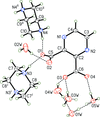issue contents
July 2015 issue

Cover illustration: Two copper(II) supramolecular coordination polymers based on the multifunctional 2-amino-4-sulfobenzoic acid ligand have been synthesized and characterized, and show different dehydration-rehydration behaviours. See Wei, Zhang, Wang, Chen, Wang & Zhang [Acta Cryst. (2015), C71, 570-577].
research papers
Download citation


Download citation


A three-dimensional metal–organic polymer: poly[bis(μ2-pyrimidine-2-thiolato-κ4N1,S:S,N3)lead(II)]
The first complex of PbII with the pyrimidine-2-thiolate ligand shows a three-dimensional structure. The pyrimidine-2-thiolate anions are coordinated in a bridging fashion through both N atoms and the S atom. The net topology is represented by a Shläfli symbol of 66.
CCDC reference: 1403855
Download citation


Download citation


A new two-dimensional zinc(II) coordination polymer containing Zn4(OH)2 secondary building units has been prepared under solvothermal conditions using benzene-1,2,3-tricarboxylic acid and N,N′-bis[(pyridin-4-yl)methylidene]hydrazine and it appears to have potential for application as a luminescent material.
CCDC reference: 1404590
Download citation


Download citation


In five copper(I) and copper(II) complexes with (prop-2-en-1-yl)bis[(pyridin-2-yl)methylidene]amine acting as a scorponiate ligand, control over the coordination geometry by modifying the counter-ion and the oxidation state of the copper center was demonstrated.
Download citation


Download citation


A three-dimensional CdII coordination polymer, with a (3,4,5)-connected topological network, was assembled from 1,1′-biphenyl-2,2′,5,5′-tetracarboxylate (bpta4−) and 1,4-bis(1H-imidazol-1-yl)benzene ligands, wherein the fully deprotonated bpta4− ligand exhibits a new coordination mode. The complex might be a candidate for a thermally stable and solvent-resistant blue fluorescent material.
CCDC reference: 1405246
Download citation


Download citation


The complexation of the dianion of pyrazine-2,3-dicarboxylic acid with CoII and ZnII has been investigated with the use of piperazinediium as the counter-cation. The structure of the starting proton-transfer reagent is also reported.
Download citation


Download citation


The structural investigation of (cryptand-222)potassium chlorido[meso-tetra(α,α,α,α-o-pivalamidophenyl)porphyrinato]manganese, [K(222)[Mn(TpivPP)Cl], reveals a near-planar conformation of the porphyrin plane, an off-axis tilting of the axial chloride ligand and a noticeable porphyrin core doming.
Download citation


Download citation


A new cadmium thiocyanate complex displays two types of CdII atoms in distorted octahedral coordination environments. Neighbouring CdII atoms are linked by thiocyanate bridges to form a one-dimensional zigzag chain and a one-dimensional coordination polymer. Hydrogen-bond interactions are involved in the formation of the supramolecular network.
CCDC reference: 1405920
Download citation


Download citation


A series of di-Schiff bases formed between benzil dihydrazone (BDH) and three isomeric chlorobenzaldehydes were designed and synthesized to be used as model compounds to help to explain the reaction mechanisms for the formation of Schiff bases.
Download citation


Download citation


Based on the bond distances and angles, and the unambiguous location of the H atoms, the crystal structures of 1-(7-chloro-1,4-dihydroquinolin-4-ylidene)thiosemicarbazide and its hydrochloride salt reveal the presence of the unusual imine tautomeric form.
Download citation


Download citation


Two copper(II) supramolecular coordination polymers based on the multifunctional 2-amino-4-sulfobenzoic acid ligand have been synthesized and characterized, and show different dehydration–rehydration behaviours.
Download citation


Download citation


The Schiff base N,N′-bis(trans-2-nitrocinnamaldehyde)ethylenediamine has a centrosymmetric molecular structure with significant twists from planarity. In the copper(I) complex, it acts as a bidentate ligand with a flattened gauche conformation for N—C—C—N and a rather bowed shape overall.
Download citation


Download citation


Three new maleates of hydrophobic L-amino acids (L-leucine, L-isoleucine and L-norvaline) are noncentrosymmetric and show an NLO effect. The crystals are promising candidates to be used as substrates for the deposition of thin films of organic molecules. Two of them show interesting mechanical behaviour.
Download citation


Download citation


In the crystal of dicyclohexylammonium bromoacetate, the anions and cations assemble through N—H⋯O interactions to form zigzag chains with the (⋯H—N—H⋯O—C—O⋯)n motif commonly found in secondary ammonium monocarboxylate gelator salts. Gelation tests revealed that the salt is capable of gelling DMF and DMSO.
CCDC reference: 1405323
Download citation


Download citation


Gd4(SiO4)2OTe was obtained as an unexpected product while studying the Gd2Te3–Cu2Te system. Excitation and emission spectra were measured using synchrotron radiation and the compound appears to be a promising optical material when doped with rare-earth ions.
CCDC reference: 1407063
Download citation


Download citation


Crystallization of the nucleobase thymine with four phenolic coformers resulted in cocrystal formation. All four structures exhibit thymine–thymine base pairing. The utilization of the donor and acceptor atoms of thymine in the hydrogen bonding is influenced by the coformers.
Download citation


Download citation


A simple reaction pathway to 5′-hydroxy-1,1′:3′,1′′-terphenyls beginning with simple aldehydes and ketones involves chalcones and diarylcyclohexenones as intermediates and examples are reported of all three compound types. The chalcone exhibits whole-molecule positional disorder and two diarylcylohexenones both exhibit enantiomeric disorder.
Download citation


Download citation


Two homochiral coordination polymers with a two-dimensional layer structure have been obtained. Photoluminescence investigations show that both these compounds display a strong emission in the blue region.
Download citation


Download citation


The article deals with the structure determination of some alkali rare-earth sulfides (KScS2, RbScS2 and KLnS2, Ln = Nd, Sm, Tb, Dy, Ho, Er, Tm and Yb) and with the crystal–chemical analysis of different variables such as unit-cell parameters, their ratios, the thicknesses of the S—S layers, sulfur's z-fractional parameters and bond valences.
Download citation


Download citation


(6-{[2-(Pyridin-2-yl)hydrazinylidene]methyl}pyridin-2-yl)methanol was synthesized by condensation of 6-(hydroxymethyl)pyridine-2-carbaldehyde with 2-hydrazinylpyridine. The three-dimensional supramolecular structure is formed by N—H⋯N and O—H⋯N hydrogen bonds and weak C—H⋯C interactions, and these were quantified by the Hirshfeld surface method.
CCDC reference: 1402540
Download citation


Download citation


In two new acylamide metal–organic frameworks (MOFs), based on mixed N- and O-donor ligands, the ZnII complex is a 4-connected CdSO4 net with no interpenetration, and the CdII complex is a 4-connected dia net with threefold interpenetration.


 journal menu
journal menu





































